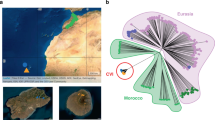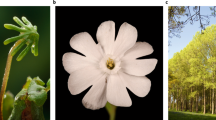Abstract
A commonly accepted evolutionary principle is that adaptive change constrains the potential directions of future evolutionary change1,2,3. One manifestation of this is Dollo's law, which states that character elimination is irreversible4,5. Although the common occurrence of irreversibility has been documented by phylogenetic analyses of phenotypic transitions, little is known about the underlying causes of this phenomenon4. One explanation for evolutionary irreversibility relies on the fact that many characteristics result from interactions between multiple gene products4,6. Such characteristics may often be eliminated by inactivation of just one gene in the network. If they serve no other functions, other genes of the network are then free to accumulate mutations or evolve new functions. Evolutionary change after character loss results in the accumulation of redundant loss-of-function mutations. Such pathway degeneration makes it very unlikely that the characteristic will re-evolve, because multiple simultaneous mutations would be required4. Here we describe what appear to be the initial stages of such degeneration in the anthyocyanin pigment pathway associated with an adaptive change from blue to red flowers in the morning glory Ipomoea quamoclit.
This is a preview of subscription content, access via your institution
Access options
Subscribe to this journal
Receive 51 print issues and online access
$199.00 per year
only $3.90 per issue
Buy this article
- Purchase on Springer Link
- Instant access to full article PDF
Prices may be subject to local taxes which are calculated during checkout




Similar content being viewed by others
References
Grant, V. Organismic Evolution (W.H. Freeman, New York, 1977)
Dobzhansky, T. Genetics of the Evolutionary Process (Columbia, New York, 1970)
Gould, S. J. The Structure of Evolutionary Theory (Harvard, Cambridge, MA, 2002)
Bull, J. J. & Charnov, E. L. On irreversible evolution. Evolution 39, 1149–1155 (1985)
Gould, S. J. Dollo on Dollo's law: irreversibility and the status of evolutionary laws. J. Hist. Biol. 3, 189–212 (1970)
Wagner, G. P. The logical structure of irreversible systems transformations: a theorem concerning Dollo's law and chaotic movement. J. Theor. Biol. 96, 337–346 (1982)
Zufall, R. A. Evolution of red flowers in Ipomoea. Thesis, Duke University (2003)
McDonald, A. Origin and diversity of Mexican Convolvulaceae. Anales. Inst. Biol. UNAM, Ser. Bot 62, 65–82 (1991)
Miller, R. E., Rausher, M. D. & Manos, P. S. Phylogenetic systematics of Ipomoea (Convolvulaceae) based on ITS and waxy sequences. Syst. Bot. 24, 209–227 (1999)
Miller, R. E., McDonald, J. A. & Manos, P. S. Systematics of Ipomoea subgenus Quamoclit (Convolvulaceae) based on ITS sequence data and a Bayesian phylogenetic analysis. Am. J. Botany (in the press)
Machado, I. C. S. & Sazima, M. A comparative study in floral biology of two weed species Ipomoea hederifolia and I. quamoclit Convolvulaceae. Rev. Brasil. De Biologia 47, 425–436 (1987)
Lava, C. & Ornelas, J. F. Preferential nectar robbing of flowers with long corollas: Experimental studies of two hummingbird species visiting three plant species. Oecologia 128, 263–273 (2001)
Faegri, D. T. & van der Pijl, L. The Principles of Pollination Ecology (Pergamon, Oxford, 1966)
Saito, N. et al. Acylated cyanidin glycosides in the violet-blue flowers of Ipomoea purpurea. Phytochem. 40, 1283–1289 (1995)
Saito, N. et al. Acylated pelargonidin glycosides in red-purple flowers of Ipomoea purpurea. Phytochem. 43, 1365–1370 (1996)
Hoshino, A. et al. Spontaneous mutations of the flavonoid 3′-hydroxylase gene conferring reddish flowers in the three morning glory species. Plant Cell Physiol. 44, 990–1001 (2003)
Zufall, R. A. & Rausher, M. D. The genetic basis of a flower-color polymorphism in the common morning glory, Ipomoea purpurea. J. Hered. 94, 442–448 (2003)
Forkmann, G. & Ruhnau, B. Distinct substrate specificity of dihydroflavonols 4-reductase from flowers of Petunia hybrida. Z. Naturforsch. 42, 1146–1148 (1987)
Dong, X., Braun, E. L. & Grotewold, E. Functional conservation of plant secondary metabolic enzymes revealed by complementation of Arabidopsis flavonoid mutants with maize genes. Plant Physiol. 127, 46–57 (2001)
Clegg, M. T. & Durbin, M. L. Tracing floral adaptations from ecology to molecules. Nature Rev. Genet. 4, 206–215 (2003)
Inagaki, Y. et al. Genomic organization of the genes encoding dihycroflavonol 4-reductase for flower pigmentation in the Japanese and common morning glories. Gene 226, 181–188 (1999)
Beld, M., Martin, C., Huits, H., Stuitje, A. R. & Gerats, A. G. M. Flavonoid synthesis in Petunia hybrida: partial characterization of dihydroflavonols-4-reductase genes. Plant Mol. Biol. 13, 491–502 (1989)
Johnson, E. T. et al. Alteration of a single amino acid changes the substrate specificity of dihydroflavonols 4-reductase. Plant J. 25, 325–333 (2001)
Harbourne, J. B. Comparative Biochemistry of the Flavonoids (Academic Press, London, 1967)
An, G., Ebert, P. R., Mitra, A. & Ha, S. B. in Plant Molecular Biology Manual (eds Gelvin, S. B. & Schilperoort, R. A.) A3, 1–19 (Kluwer, Dordrecht, 1988)
Clough, S. J. & Bent, A. F. Floral dip: a simplified method for Agrobacterium-mediated transformation of Arabidopsis thaliana. Plant J. 16, 735–743
Stafford, H. A. & Lester, H. H. Enzymatic and nonenzymatic reduction of (+ )-dihydroquercitin to its 3,4-diol. Plant Physiol. 70, 695–698 (1982)
Manos, P. S., Miller, R. E. & Wilkin, P. Phylogenetic analysis of Ipomoea, Argyreia, Stictocardia, and Turbina suggests a generalized model of morphological evolution in morning glories. System. Bot. 26, 585–602 (2001)
Swofford, D. L. PAUP*. Phylogenetic Analysis Using Parsimony (*and Other Methods), Version 4.0 (Sinuar Associates, Sunderland, Massachusetts, 2000).
Acknowledgements
This work was supported by NSF grants.
Author information
Authors and Affiliations
Corresponding author
Ethics declarations
Competing interests
The authors declare that they have no competing financial interests.
Supplementary information
Supplementary Information
Includes a detailed description of methods and one table of PCR primer sequences. (DOC 44 kb)
Rights and permissions
About this article
Cite this article
Zufall, R., Rausher, M. Genetic changes associated with floral adaptation restrict future evolutionary potential. Nature 428, 847–850 (2004). https://doi.org/10.1038/nature02489
Received:
Accepted:
Issue Date:
DOI: https://doi.org/10.1038/nature02489
This article is cited by
-
Stamen curvature and temporal flower closure assure reproductive success in an early-spring-flowering perennial in the cold desert of Middle Asia
Journal of Plant Research (2023)
-
Phenotypic plasticity explains apparent reverse evolution of fat synthesis in parasitic wasps
Scientific Reports (2021)
-
The complexity of the Fragaria x ananassa (octoploid) transcriptome by single-molecule long-read sequencing
Horticulture Research (2019)
-
Geography is essential for reproductive isolation between florally diversified morning glory species from Amazon canga savannahs
Scientific Reports (2019)
-
Genome-scale transcriptional study of hybrid effects and regulatory divergence in an F1 hybrid Ruellia (Wild Petunias: Acanthaceae) and its parents
BMC Plant Biology (2017)
Comments
By submitting a comment you agree to abide by our Terms and Community Guidelines. If you find something abusive or that does not comply with our terms or guidelines please flag it as inappropriate.



